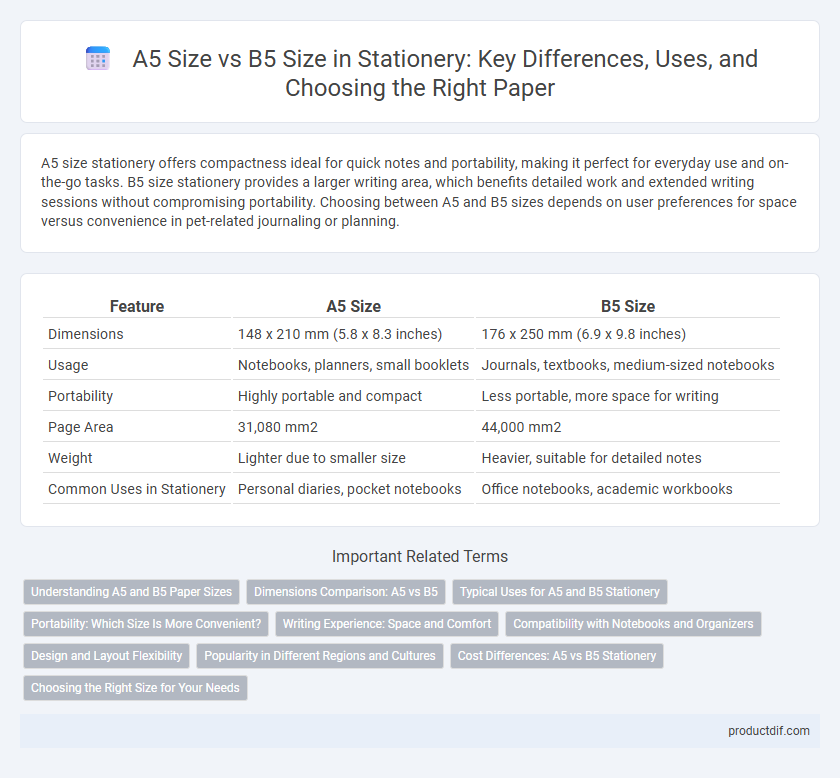A5 size stationery offers compactness ideal for quick notes and portability, making it perfect for everyday use and on-the-go tasks. B5 size stationery provides a larger writing area, which benefits detailed work and extended writing sessions without compromising portability. Choosing between A5 and B5 sizes depends on user preferences for space versus convenience in pet-related journaling or planning.
Table of Comparison
| Feature | A5 Size | B5 Size |
|---|---|---|
| Dimensions | 148 x 210 mm (5.8 x 8.3 inches) | 176 x 250 mm (6.9 x 9.8 inches) |
| Usage | Notebooks, planners, small booklets | Journals, textbooks, medium-sized notebooks |
| Portability | Highly portable and compact | Less portable, more space for writing |
| Page Area | 31,080 mm2 | 44,000 mm2 |
| Weight | Lighter due to smaller size | Heavier, suitable for detailed notes |
| Common Uses in Stationery | Personal diaries, pocket notebooks | Office notebooks, academic workbooks |
Understanding A5 and B5 Paper Sizes
A5 paper size measures 148 x 210 mm, making it compact and ideal for notebooks, planners, and flyers that require portability. B5 paper size, at 176 x 250 mm, offers a larger surface area suitable for journals, textbooks, and official documents demanding more writing space. Understanding the dimensional differences between A5 and B5 helps in selecting the appropriate paper size for specific stationery needs and printing requirements.
Dimensions Comparison: A5 vs B5
A5 size measures 148 x 210 mm, making it compact and ideal for portable notebooks or planners. B5 size, at 176 x 250 mm, offers a larger writing surface suitable for detailed notes and documents. Comparing dimensions, B5 provides approximately 40% more area than A5, enhancing usability for tasks requiring more space.
Typical Uses for A5 and B5 Stationery
A5 size stationery, measuring 148 x 210 mm, is commonly used for personal notebooks, planners, and flyers due to its compact and portable format. B5 size stationery, at 176 x 250 mm, is favored for academic notebooks, official documents, and magazines, offering a larger writing surface for detailed notes and formal presentations. Both sizes cater to different needs, with A5 excelling in mobility and convenience, while B5 provides ample space for comprehensive content.
Portability: Which Size Is More Convenient?
A5 size stationery is more convenient for portability due to its compact dimensions of 148 x 210 mm, fitting easily into smaller bags and allowing for effortless handling on the go. B5 size, measuring 176 x 250 mm, offers more writing space but is less convenient for travel or daily carry because of its larger size and weight. For students and professionals prioritizing mobility, A5 notebooks and planners provide an optimal balance between functionality and ease of transport.
Writing Experience: Space and Comfort
A5 size notebooks offer a compact writing surface ideal for quick notes and portability, but may limit space for extensive writing or detailed work. B5 size provides a larger area that enhances comfort and allows more room for organized, expansive writing, making it suitable for longer sessions and detailed note-taking. Writers prioritizing space and ease of legibility often prefer B5 for its balance between portability and comfort.
Compatibility with Notebooks and Organizers
A5 size paper, measuring 148 x 210 mm, is widely compatible with compact notebooks and portable organizers, making it ideal for everyday note-taking and easy storage. B5 size, at 176 x 250 mm, offers a larger writing surface and is better suited for academic planners and professional organizers that require more space for detailed notes. Choosing between A5 and B5 depends on your preference for portability versus expanded writing area in notebooks and organizers.
Design and Layout Flexibility
A5 size offers compactness ideal for minimalistic designs and easy portability, making it perfect for simple layouts with limited content. B5 size provides greater design and layout flexibility due to its larger dimensions, accommodating detailed graphics and more extensive text while maintaining readability. Designers often choose B5 for projects requiring a balance between usability and creative space, whereas A5 suits concise and straightforward formats.
Popularity in Different Regions and Cultures
A5 size stationery is widely favored in Europe and Japan for its compactness and portability, making it ideal for personal organizers and notebooks. B5 size holds greater popularity in East Asian countries like China and Korea, where it is commonly used for academic and professional documents due to its larger writing space. Regional preferences are influenced by traditional paper standards and cultural emphasis on organization and presentation.
Cost Differences: A5 vs B5 Stationery
A5 stationery generally costs less than B5 due to its smaller size, which requires less paper and materials during manufacturing. Printing and shipping expenses for A5 items are also lower, contributing to overall cost savings for businesses and consumers. However, for projects needing more space or detailed layouts, the increased cost of B5 stationery may be justified by its larger dimensions.
Choosing the Right Size for Your Needs
A5 size notebooks measure 148 x 210 mm, offering a compact and portable option ideal for quick notes and daily journaling, while B5 size notebooks at 176 x 250 mm provide more writing space, suited for detailed work and professional use. Choosing the right size depends on your primary needs; A5 fits easily into bags and is perfect for casual note-taking, whereas B5 supports larger text layouts and comprehensive note organization. Consider portability versus available writing area to select the stationery that best matches your personal or professional requirements.
A5 size vs B5 size Infographic

 productdif.com
productdif.com